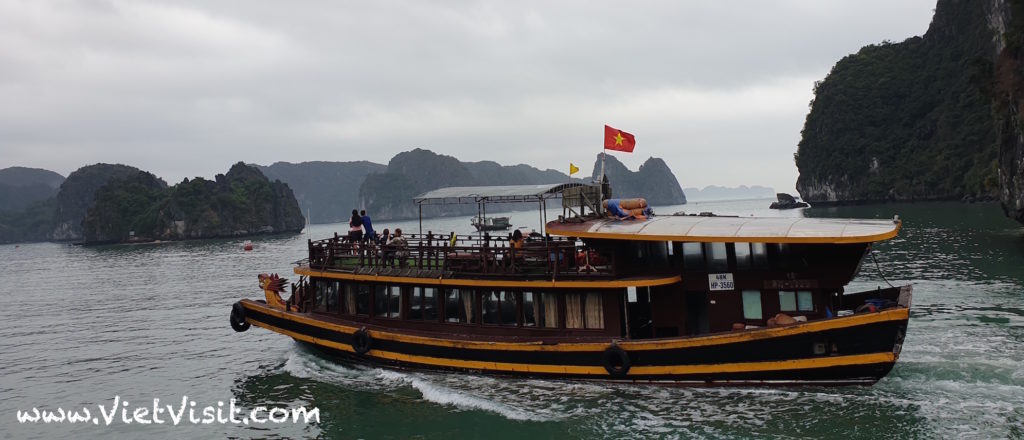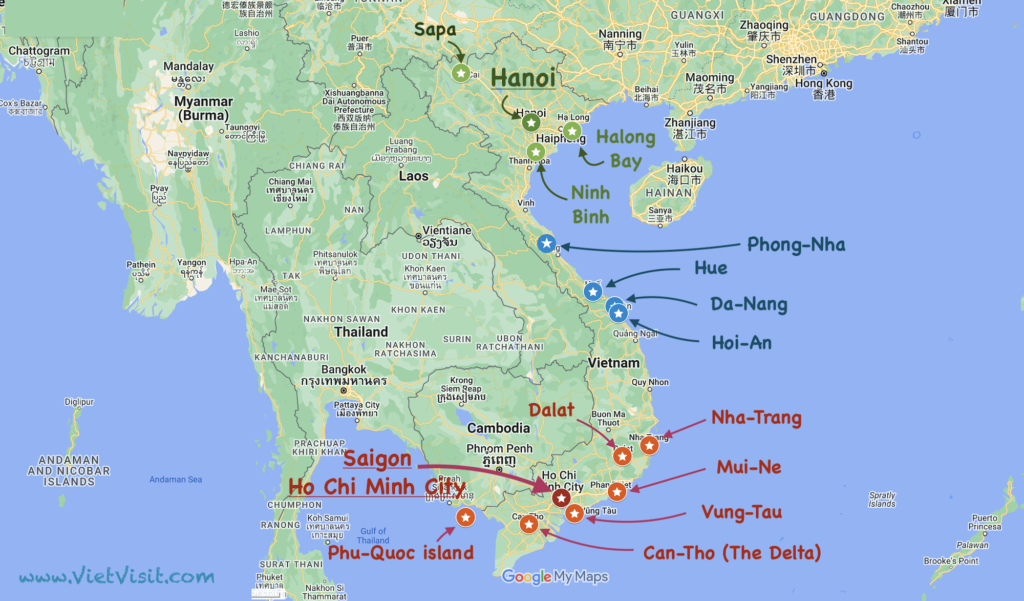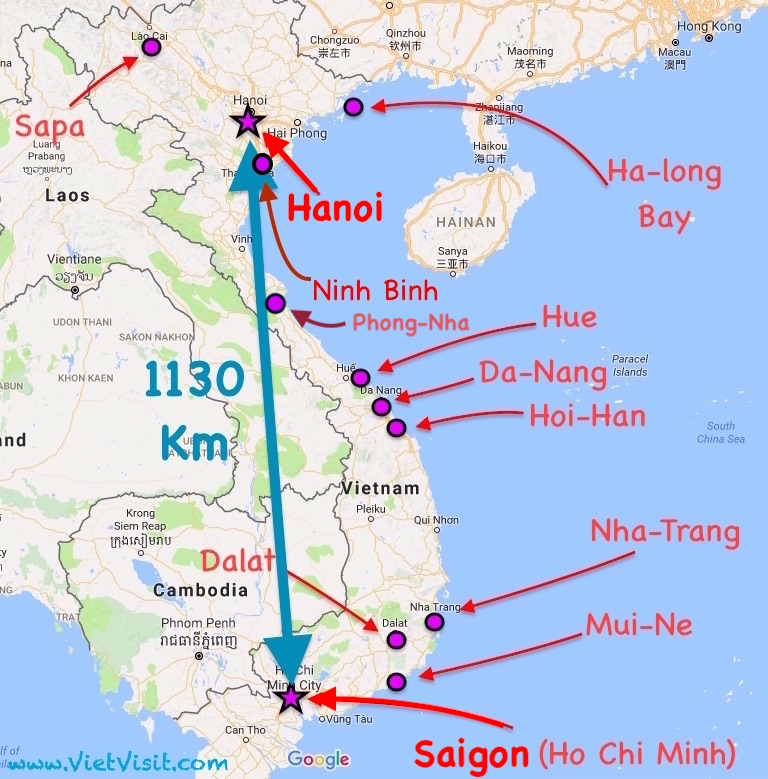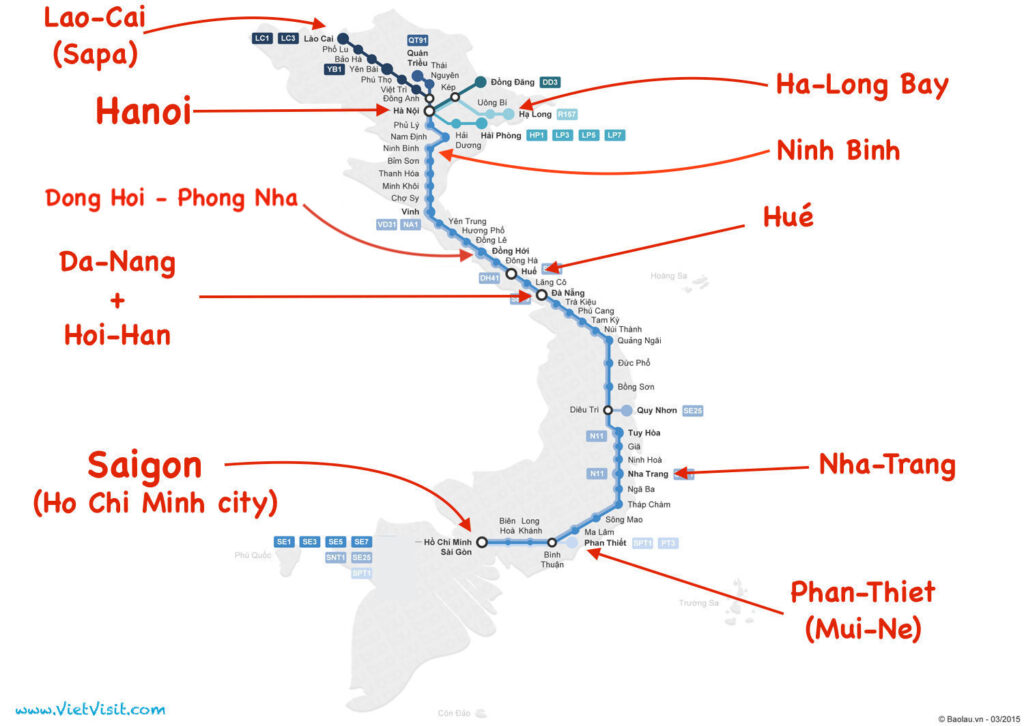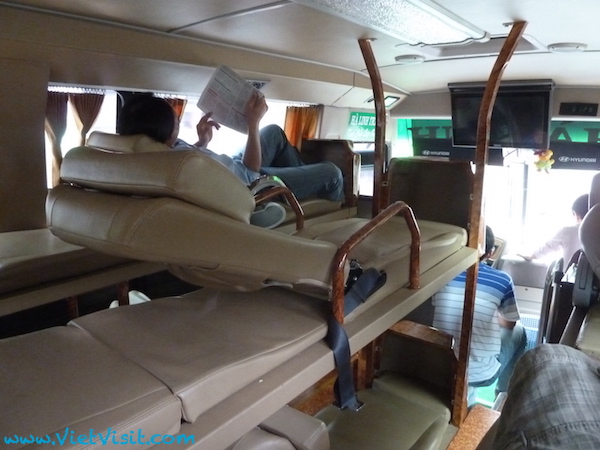This site is about the main places to Visit in Vietnam. On this page I will show you how to move in Vietnam and what to Visit. I also give my opinion about the priorities, in case you are limited in time. You will also find information about issues like cost, visa, Internet and more.
Maps – Orientation
Look at the following map, click to enlarge :
And this Google Interactive Map :
On this Page :
- Where to land in Vietnam ?
- Feel the distances and timing
- How to move in Vietnam ?
- In Brief – How is each city ? – A quick overview
- In Detail – Where to Stay, What to Visit, How to Arrive?
- South Vietnam
- Middle Vietnam
- North Vietnam
- The priorities – If you don’t have time – What to Visit first ?
- When is the best time to visit Vietnam ?
- How to receive a tourist Visa for Vietnam ?
- How much does it Cost to visit Vietnam ?
- How is the Internet in Vietnam ?
- Is Vietnam Safe for tourists ?
- How to Reserve Hotels, Trains, Flights, Buses, Travel Insurance for Vietnam ?
Where to land in Vietnam ?
Option 1
As you can see from the map above, Vietnam has a vertical long shape and this shape makes it very convenient for visiting, you just travel from one extreme to the other (avoid countries that have a round shape). You usually arrive to Vietnam by landing in one of the 2 big cities : Hanoi (north) or Saigon (South). Then you travel from Saigon to Hanoi (or the opposite direction, it doesn’t matter) and visit places along the way.
See the page Saigon vs Hanoi, in which I compare the 2 cities, from a tourist point of view.
Note : You can also arrive to Saigon, by land (bus) from Cambodia.
Option 2
You can land in the middle of Vietnam, in the city of Danang (there are some international flights), in case you want to prioritise a visit to the nearby city of Hoi-An (or if you want to visit just half of Vietnam).
Option 3
You can also start your Vietnam journey by landing in Phu Quoc island, in the south, if you have extra time.
Feel the distances and timing
The aerial distance between Saigon and Hanoi is 1130 Km. Da-Nang (the third largest city) is midway.
The trains and buses are slow in Vietnam (the airplanes fly normally) and if you will decide to travel by train non-stop between Hanoi and Saigon (why??) it will take you more than 24 hours. You are supposed to stop and visit places on your way, if not just take an airplane.
In 1 month you can visit many of the highlights of Vietnam. Try to stay 3 months, it is much better. In my first visit in Vietnam, I went from Saigon to Hanoi and in 1 month I stayed in just 6 cities. I travelled with trains and buses, no airplanes. Of course that you can visit much more places in one month but you may see the background blurred. I recommend to travel slowly and enjoy each place.
See later on the page, possible priorities for a visit (in case you are short in time).
How to Move in Vietnam ?
Flights in Vietnam
As you can see from the following map, the main attractions are grouped in 3 zones, so you may decide to fly between them in order to gain time (or comfort). The 3 main airports are in Hanoi, Saigon and Da-Nang (International airports). There are domestic airports near most places, except Sapa which is in the mountains.
There are many internal flights in Vietnam and they are not expensive.
 See how to reach each touristic city.
See how to reach each touristic city.
 You can book Flights, Trains and Buses inside Vietnam with the site Baolau or 12Go Asia. Choose the Origin city and Destination city and it will show you All the available Transports to destination.
You can book Flights, Trains and Buses inside Vietnam with the site Baolau or 12Go Asia. Choose the Origin city and Destination city and it will show you All the available Transports to destination.
Trains in Vietnam
As you can see from the following Map, there is a main railway that goes vertically in Vietnam. It’s called the “reunification line”.
Click to enlarge the Map :
It’s possible to reach with the train all the touristic towns mentioned on this page (except Dalat, Can-Tho, Phu Quoc and Vung Tau). In most cases the train station is in town, but for some destinations it is 30 or 50 km away and then you need to complete the journey with a short ride in taxi or a bus (it is the case of Hoi-An).
The trains in Vietnam are fun and comfortable and they have sleeping wagons because a trip from Saigon to Hanoi takes one day and a half. There are no bullet trains like in Japan or China, yet.
The trains are not expensive. Travelling from Hanoi to Saigon in a sleeping coach is about 50 dollars.
 See how to reach each touristic city.
See how to reach each touristic city.
 You can book Flights, Trains and Buses inside Vietnam with the site Baolau or 12Go Asia. Choose the Origin city and Destination city and it will show you All the available Transports to destination.
You can book Flights, Trains and Buses inside Vietnam with the site Baolau or 12Go Asia. Choose the Origin city and Destination city and it will show you All the available Transports to destination.
 You can read more details about the trains in Vietnam in the excellent site : Seat61.
You can read more details about the trains in Vietnam in the excellent site : Seat61.
Buses in Vietnam (long distances)
Two main categories :
- Public buses (regular lines) that travel between central bus stations in the towns.
- Private bus companies that collect and drop passengers in tourist areas and even pick up from the hotels.
The open bus “Hop-on /Hop-off ” tickets of the private bus companies :
The open ticket goes like this : You pay in advance for a long trajectory, let’s say from Saigon to Hanoi. You don’t travel all the trajectory at once but spread it on time. For example : you first travel from Saigon to Mui-Ne, you stay in place for 3 days, later travel from Mui-Ne to Nha-Trang and so on. Each time that you want to use the buses, you need to contact the company and reserve your place in advance (but not pay).
Of course that you can also purchase individual travels with these companies (not an open ticket).
For journeys at night, there are usually beds inside the bus (the beds are not like at the hotel…).
 See how to reach each touristic city in Vietnam.
See how to reach each touristic city in Vietnam.
 You can book Flights, Trains and Buses inside Vietnam with the site Baolau or 12Go Asia. Choose the Origin city and Destination city and it will show you All the available Transports to destination.
You can book Flights, Trains and Buses inside Vietnam with the site Baolau or 12Go Asia. Choose the Origin city and Destination city and it will show you All the available Transports to destination.
Renting a Motorbike in Vietnam
There are more motorbikes than cars in Vietnam, and it is very easy for tourists to rent one. The common price is 150,000 Dong per day. Gasoline is cheap.
Where to rent ?
Usually, tourists are renting a motorbike in order to visit the attractions located outside of a city, like beaches, temples etc. These are distances of around 10 to 30 Km. Usually tourists avoid renting a motorbike in Hanoi and Saigon, because :
- There are alternatives, like Grab Taxi-Moto
- Most of the attractions are inside town
- The traffic is intense
- It is difficult to park
Rent a moto from a shop or from your hotel ?
It is easier to rent it from your hotel, but if you will rent it directly from the shop, you may get a small discount. You will also be able to choose a motorbike that is more new (rented motos are in bad conditions in Vietnam). The disadvantage of a shop is that they will ask you to leave your passport, and the hotel probably not (because you are already their client). The hotel doesn’t keep motorbikes, they just bring you one, from a shop.
My advice : When you receive the moto, take photos of it (with your smartphone), from all angles. Just in case, that they will accuse you of having damaged the moto.
The motorbikes are usually of 125 CC. There are motorbikes with automatic gear and manual ones.
Theft of motos in Vietnam
Theft of motos are common in Vietnam. That’s why you should always park the moto in a place with a guard. Everybody is doing so, especially in the big cities. The common price is 5000 Dong.
Motorbike between cities in Vietnam
Yes, you can do that. It depends if you intend to return the moto to the same place, or deposit it another city. There are some agencies, who accept to return the moto in another town, they may even take your bag by bus. Inform yourself at the hotel, about these agencies. For example they exist between Hoi-An and Hue.
Do I need a licence to drive a Moto in Vietnam ?
By law, you need a licence but usually you will not be asked for it, unless you are involved in troubles.
Rental shops and hotels will not ask you for a licence, they do business.
So when will you need a driving licence ? Two cases :
Case 1 : If you are involved in a road accident : If you need medical assistance, your health insurance (or life insurance) may “be unhappy” that you drove without a licence. If you made damage to other persons, the police may dig into the licence issue.
Case 2 : If you are stopped in a routine check-up barrier by the police : The police are sometimes making controls of drivers. They may give a small fine for not driving with a licence or helmet.
Which licence is needed :
An international one, for motorbikes. There are offices in your country who can print you an international licence, valid for 1 year, based on your normal local driving licence (ask a travel agency in your country, they will tell you where). In many countries the car licence include also the permission to ride small motorbikes.
Anyway, try not to do an accident and put an helmet. Drive slowly and preferably not when the road is wet.
Renting a car in Vietnam
Usually, when we are talking about car rental in Vietnam, we are talking about a car that comes with a driver (so it is a sort of Taxi).
Car rental, in which you drive is not common in Vietnam, and take into account :
- The international car rental companies are not present in Vietnam, so if you find someone who may accept to rent you a car, it will be a local company.
- It will be expensive.
- The traffic is intense and problematic in Vietnam.
- The police is making routine checks on the roads, and it is not clear how they may react to a tourist driving a car.
- You surely need an international driving license (you need to receive an international driving licence, in your country, based on the local one).
A car with a driver :
It is very common in Vietnam. Ask your hotel and they will arrange you one for the entire day or for many days.
Taxi and Grab in Vietnam
Taxis in Vietnam
The service is efficient. A common ride in town may cost 3 dollars. Between an airport and a city center, it can cost 10 dollars (it depends on the distance, of course).
Make sure the taxi-meter is on, at the start of the ride.
Grab in Vietnam
Grab is a company like Uber, and it is the most common company in Vietnam.
Grab is like Taxis, but it functions via an application of the smartphone.
In Vietnam, it works with Cars and Motorbikes.
I wrote an explanation about using the Grab application, in the Transport page of Saigon.
Motos of “freelancers”
There are also private persons, who have a motorbike and will address you on the streets of Vietnam, proposing you a ride. It is less interesting than Grab, because :
- Their motos are in bad shape
- They drive dangerously and sometimes they are drunk
- They ask for a higher price than Grab
- They try to bring you to places, that you didn’t ask for
- They don’t speak english and you need to explain to them about your destination.
What to Visit in Vietnam ?
See this on the second page.
If you don’t have time – What to Visit first ? – The priorities
Note 1 : I will give you here my priorities for the places to visit in Vietnam.
Take into account that it is only my personal opinion. My consideration is how special and unique is a place. For example, there are islands in Vietnam, like “Phu Quoc”, but I am not sure it is the most special place that you can see in Vietnam (there are a lot of islands in Thailand).
Note 2 : If you are short in time and you want to limit traveling, you can decide to skip south Vietnam and concentrate on the north and middle Vietnam. Why skip the south and not the north ? Well, most travelers think that the north of Vietnam is more interesting from a touristic point of view.
Must Visit :
- Hanoi – The capital of Vietnam. Don’t miss this destination, it is unique. The old quarter with its nightlife, the lake, the museums. And indeed, all the tourists to Vietnam, are visiting also Hanoi.
- Saigon – Theoretically, it is less special than Hanoi. If you must choose between the 2 cities and you are a tourist, then choose Hanoi. Still, Saigon is the economic center of Vietnam and it has modern malls and a lot of cafés and an international spirit. It is probably the city you would choose to live in Vietnam, and indeed, most of the expatriates are living in Saigon.
- Hoi-An – A must visit, a unique old city. It is also a pleasant place.
- Halong-Bay – Very special the “island-rocks” in the water.
- Ninh Binh – Like Halong Bay, this is a very scenic area and relatively close to Hanoi.
- Sapa or Dalat – Both are cities in the mountains. If you are limited in time, then choose only one of them. Sapa is more special and “extreme”, but it is also more difficult to access (no airport in Sapa, in Dalat yes).
- Hue – An important historical city with a citadel. Quite special.
What can you skip ?
Don’t skip these places, if you have time !
- Mui-Ne and Nha-Trang and Vung Tau– They are “beach cities”. They are pleasant, but maybe not as special as the destinations mentioned before. You could choose one of them.
- Dalat (or Sapa) – As I said before, both are cities in the mountains. If you are limited in time, choose only one of them.
- Danang – A big city near Hoi-An and Hue. If you are limited in time, you can skip Danang and visit its attractions from Hoi-An, with one day trips. The Attractions are the Marble mountain and the Ba-Na hills.
- Phu Quoc island – A popular destination in the south of Vietnam, near Cambodia. I prefer the islands of Thailand.
- The Delta – South of Saigon, there is the region of “the Delta” with cities like “Can Tho”. The special thing are the floating markets (little boats that are selling food). If you are limited in time, then just take an organised one day trip from Saigon. Floating markets are common in Asia, for example in the suburbs of Bangkok, Thailand.
- Phong Nha – A rural area with amazing caves – You can save this place for your second visit in Vietnam. Phong Nha is a little bit more difficult to reach and the rural landscape is more beautiful in Ninh Binh. On the other hand, you can make this place part of a visit to the north of Vietnam (and skip the south of Vietnam).
When is the Best Season to visit Vietnam ?
The question is what do you like more : Rain or Many Tourists ?
In Vietnam (and the neighbouring countries), there is a rainy season and a dry season. The dry season is from December to May. That’s also when most of the foreign tourists choose to visit Vietnam (also because it is cold in Europe). It is called the high season for tourism.
The best time to visit Vietnam may be at the limit of the high season : In January and in May. At this time there are not a lot of tourists and not a lot of rain.
You can see in the following table the average rain, in the 3 big cities of Vietnam. These cities represent quite well the south, middle and north of Vietnam, in terms of rain.
As you can see, in Da-Nang the rainy season starts later, it starts in August instead of May (it is the same for the nearby cities of Hoi-An and Hue).
Rain in Vietnam (mm) |
|||
Month |
Saigon(South Vietnam) |
Da-Nang(Middle Vietnam) |
Hanoi(North Vietnam) |
| January | 14 | 85 | 18 |
| February | 4 | 25 | 19 |
| March | 10 | 20 | 34 |
| April | 50 | 35 | 105 |
| May | 218 | 84 | 165 |
| June | 312 | 90 | 266 |
| July | 294 | 87 | 253 |
| August | 270 | 117 | 274 |
| September | 327 | 312 | 243 |
| October | 267 | 650 | 156 |
| November | 116 | 432 | 59 |
| December | 48 | 216 | 20 |
As for the temperatures, look at the following table :
You may notice that it is mostly hot in Vietnam, especially in the south and the middle.
Temperatures in Vietnam (Celcius)(Average Night and Average Day) |
|||
Month |
Saigon(South Vietnam) |
Da-Nang(Middle Vietnam) |
Hanoi(North Vietnam) |
| January | 21 —- 32 | 19 —- 25 | 14 —- 20 |
| February | 22 —- 33 | 20 —- 26 | 15 —- 20 |
| March | 24 —- 34 | 21 —- 28 | 18 —- 23 |
| April | 26 —- 35 | 23 —- 31 | 22 —- 27 |
| May | 25 —- 34 | 25 —- 33 | 25 —- 31 |
| June | 25 —- 32 | 26 —- 34 | 26 —- 33 |
| July | 24 —- 32 | 25 —- 34 | 26 —- 33 |
| August | 24 —- 32 | 25 —- 34 | 26 —- 32 |
| September | 24 —- 31 | 24 —- 32 | 25 —- 31 |
| October | 24 —- 31 | 23 —- 29 | 22 —- 29 |
| November | 23 —- 31 | 22 —- 27 | 19 —- 25 |
| December | 21 —- 31 | 20 —- 34 | 16 —- 22 |
There is a difference of temperatures between the south and the north of Vietnam. The north is cooler. In some months there is a difference of 10 degrees Celsius between Hanoi and Saigon. You need a sweatshirt in the north.
Sapa and Dalat are cities in the mountains. They are cooler. In Sapa, on some months it can reach 0 Celsius at night. See average temperatures and rain in Sapa. In Dalat, it is just mildly cool in the evenings. A lot of people from Saigon escape the heat of the city and come to relax in the cooler Dalat, for a week-end. See average temperatures and rain in Dalat.
Note :
- Vietnam is a long country, with mountains and beaches, there is a difference in the weather between places. The rainy season is not starting and ending exactly at these months.
- Assuming you are a typical tourist and will visit the main attractions in the south and north of Vietnam, it may be difficult to optimise the time of visit to avoid rain, heat, cold and many tourists.
- Rain is not necessarily bad. It usually lasts only 2 hours in the afternoon and it protects from the sun.
- Tourists are not necessarily bad, they add to the atmosphere of a place (beaches without tourists, may be sad).
- If you visit big cities like Saigon and Hanoi, the rain is less problematic, you can go to a shopping mall.
- In high season, hotels are more expensive and more occupied but it is not as bad as the high season in Europe. There are a lot of Hotels in Vietnam.
 Continue to Page 2 – What to Visit in Vietnam ?
Continue to Page 2 – What to Visit in Vietnam ?
 More on Vietnam :
More on Vietnam :
- How to Visit Vietnam ? – Transport, Best Time, Priorities…
- How to Reserve : Trains, Buses and Flights in Vietnam ?
- How much does it Cost to Visit Vietnam? Common Prices
- How to get a Visa for Vietnam ?
- Where to Stay, What to Visit, How to Arrive to :
- How is the Internet in Vietnam ?
- Is it Safe to visit Vietnam?
- What to Pack for the trip to Vietnam ?
 On Thailand :
On Thailand :
- Bangkok – What to Visit, Where to Stay, Transport…
- The Islands in Thailand – Which one to choose, Where to stay, How to arrive ?
- Chiang Mai – What to Visit, Where to Stay, Transport…
- Pattaya city – What to Visit, Where to Stay, Transport…
 Other Stuff :
Other Stuff :
- What to Pack ? the visual list that will help you prepare the suitcase.
- Visit my Vegetarian Page. Why be Vegetarian ? What to eat ?
- Visit my Salsa Dance Page. Salsa main Styles. Why Dance Salsa ?
- See City Information about 2 more cool cities: Barcelona and Tel-Aviv.
- Listen to nice Songs with translation in French, Spanish, Italian, Hebrew.
- Listen to basic Words In Spanish, French, Hebrew
![]() If you find incorrect data on this page, like a restaurant that has closed or a big river that has moved or you want to tell me something, please write me to contact.
If you find incorrect data on this page, like a restaurant that has closed or a big river that has moved or you want to tell me something, please write me to contact.
